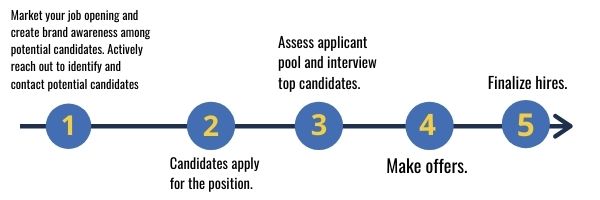Sales recruiting shouldn’t be an ongoing struggle to counteract the high turnover rates typically seen on sale teams. In fact, establishing the right procedures for repeatable hiring success can ensure you never have lapses in your sales workforce – and that you’re always hiring the best fit for your team.
Why do you need a repeatable recruiting process?
“Good sales managers are always recruiting”
In sales, your team is always evolving. Sales teams have high turnovers; according to The U.S. Bureau of Labor Statistics, the average time a sales professional stays with one company is just two years, compared to four years for an average employee across all industries. This means that you’ll want to establish and hone a go-to sales recruiting process that is sustainable and repeatable. This requires some work on the front end, but you’ll see the results in higher retention, more quotas met, and better team dynamics and morale.
Good sales managers are always recruiting for sales. They’re also always top-grading their team, which means reviewing team members on a quarterly-to-annual basis; assessing who are the A-players and who are the C-players; and making sure reps are advancing in their abilities and the results they’re achieving. Those who aren’t will be weeded out.
This doesn’t just mean you’ll lose reps because you let the C-players go. Poor-performing reps will also self-select out. Some may find that sales isn’t the right career for them, and they’ll look for something else.
Others may find that they perform better in a different sector of sales that they’re more passionate about. Top-tier reps may also leave, as they get recruited away by competitors.
Because sales is a constantly-changing landscape, if you stop sales recruiting, you’ll find yourself with a shortage of reps. This will place added responsibilities on your existing reps, diminish morale, and decrease overall sales. Accounts may go unassigned, and quotas will continue to accumulate.
Before you start
First, you should define your ideal candidate. In order to do this, you need to understand and define what you’re recruiting for:

To find what you’re looking for, you need to know what you’re looking for.
Second, upgrade your systems, or invest in systems you don’t have yet, but should (for example, LinkedIn Recruiter or an applicant tracking system). You can get by with a Google Sheet, but upgraded technology will make the sales recruiting process more time-efficient and cost-efficient.
Third, upgrade your company’s social presence and persona. The first places potential candidates will go to find out more about your company are your website or your social media. Make sure you have an updated Careers page on your website, along with positive testimonials from current sales reps (video testimonials are particularly helpful).
You should also have a diverse social media presence, with LinkedIn and Facebook at the minimum. Depending on your industry, an Instagram presence may align with your brand.
Fourth, upgrade the hiring team’s social presence and profiles. Make sure their titles are up to date and that they are actively engaging on platforms like LinkedIn on behalf of the company (like sharing any company achievements or new products).
Lastly, know what reviews exist about your company from current or former employees, especially on Glassdoor. Assume that all the candidates you interview have checked your Glassdoor presence. If there are any negative comments, you should be prepared to address these issues.
Candidate sources
Where are you sourcing your candidates?
LinkedIn and Indeed are two of the most popular recruiting sites, but you should regularly review the recruiting landscape. New platforms and avenues for sales recruiting are emerging all the time, focusing on more targeted markets and using tools like cutting-edge AI technology. A platform like TitanHouse can provide advanced information on candidates and use matching analytics to bring you the ideal fit.
You should also consider third-party recruiters when needed, as well as internal sales recruiting incentives. Your ideal sales candidate may actually already be working for your company in a different role. The benefit of recruiting internally is that you’ll source candidates who are already familiar with your company culture, goals and teams.
Also, consider competitor companies or companies from different industries whose sales models have impressed you. You may want to approach reps who are currently working for these companies.
Be prepared to “sell” your own company to them, and why your company is a better fit. What can you offer them that their current company can’t? It may not always be money. They may be looking for better benefits, a different corporate culture, or a more flexible remote-work environment.
In general, the best sales recruiters source candidates where sales reps are networking.
This goes far beyond Linkedin. Consider various Slack communities; Sales Hacker, open to B2B sales professionals; and AA-ISP, the Global Inside Sales Association, a resource for remote and virtual sales reps and leaders.
Finally, don’t discount the importance of employee referrals. Referrals are the leading source of superior candidates for 88% of employers. Referral candidates are also typically a better cultural fit, and they tend to pass on the favor: Almost two-thirds of referred employees referred at least one person to their current company.

Have a site where your employees can refer a candidate to an open position online. Incentivize employee referrals with cash bonuses, gift cards, or extra vacation days.
Building your candidate bench
A recruitment funnel is a framework that helps you narrow down your candidate pool.
Need help defining your ideal criteria? Learn about Creating a Candidate Persona for Sales Recruiting: What Does “Good” Look Like?
Sales recruiting funnels should look similar to sales funnels. You should approach how you recruit new employees the same way you approach client or customer prospects. You are “selling” the position in the same way you are selling your company’s product or service, so you want to make both your company and the position as attractive as possible to engage the best talent.

Understand your recruiting Key Performance Indicators (KPIs), or talent acquisition metrics. This includes things like time to hire (how quickly is a candidate hired after entering the system?) and the efficiency of the platforms or channels you are using to source candidates (how many applicants did you get from each source?).
You also shouldn’t underestimate the importance of giving all candidates a respectful, easy application experience. In all likelihood, the candidates you reject will have other reps in their network who may apply to your company in the future. You want to keep your brand reputation intact. This means contacting applicants quickly and keeping them informed of where they are in the process.
Hiring entry level reps? Check out How to Hire the Best SDRs/BDRs for Your Sales Team
Defining your interview process
Your interview process should be clearly defined before you start sourcing candidates.
Once you develop the right process, it can be repeatable for multiple positions. You should also determine the interview questions that will help you identify the best-fitting candidates for your company’s and your team’s goals. These will differ somewhat between sales reps and sales managers.
If you want multiple people on your sales recruiting team, make sure everyone is on the same page when it comes to the interview process.
During an interview, everyone on the hiring team in the room should be working from the same notes and be prepared to conduct the interview in a pre-determined format. Know ahead of time who will take the lead in asking the first questions, and what those questions will be.
An example of an interview process looks like this:
- Resume screening
- Introductory phone call with potential candidates
- Internal assessment of candidates among the hiring team
- In-person initial interview of [x] candidates
- Second or final interview of [x] candidates
- Check references
- Make an offer!
Great interview questions
Tell us about your first job
Good sales reps need grit and work ethic. They need to understand the value of persistence and hard work. There’s a difference between a rep who has been working since high school and one whose first job was at age 22.
Tell us something you learned in your last job.
Great reps should always be learning. Those who think they know everything may not be able to adjust or adapt to new sales techniques. Use this question to assess coachability and attitude. Cockiness in a sales rep will sour your prospects, but humility in excess can also be a bad thing. At this point in the sales recruiting process, you’re looking for a combination of likeability, self-assuredness and a willingness to learn.
Do you prefer working with teams or alone?
Depending on how your team is structured, you may not be looking for someone to collaborate all the time. But the best sales teams are just that – teams. They share information and best practices and encourage each other along the way. Avoid candidates who tell you they don’t work well in a team environment.
How do you establish a relationship with a prospect?
You’ll want to pay attention here to how much research a candidate typically does on a potential client, how often they contact them, and whether, in their last position, they spent more time cultivating customer relationships or looking for new clients (your needs will differ based on your open position).
Why our company?
Use this question to see what it is about your company or your solutions that they’re passionate about. Does the candidate really understand your marketplace or industry? Do they fully understand your solutions and how they impact your clients? They should demonstrate knowledge about your business/products, and articulate key points with passion.
When you close on a candidate, close quickly and aggressively, and know your competition.
Sales recruiting is a competitive landscape – the candidate may be fielding other offers at the same time. Ideally, during the interview process, you’ll have gotten a good idea of what “drives” the candidate – do they value financial compensation, flexibility, etc.?
Understand their decision-making process and know what lever you have to pull to “win” the candidate. In doing this, it’s important to understand the value of the candidate. Are they a rock star or a role player? You may not want to extend certain “carrots” to a roll player so that you can save those resources for the rock stars.
Do you have a career plan set up for reps on your sales team? Here’s Why Your Company Should Invest in a Sales Career Plan




